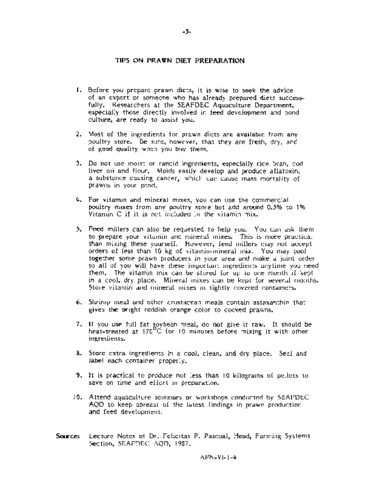Browsing Aqua Farm News by Title
Now showing items 258-277 of 286
-
Third world aquaculture systems: Environmental impacts and benefits for producers
(Aquaculture Department, Southeast Asian Fisheries Development Center, 1991) -
Tiger shrimp pens in Thailand
(Aquaculture Department, Southeast Asian Fisheries Development Center, 1994)The article discusses the tiger shrimp (Penaeus monodon) pen culture practices in Thailand. Suitable sites, pen construction, rearing and harvesting techniques, and return on investment are also discussed. -
Tilapia genetic resources in Asia
(Aquaculture Department, Southeast Asian Fisheries Development Center, 1993) -
Tilapia hatchery and nursery
(Aquaculture Department, Southeast Asian Fisheries Development Center, 1993) -
Tips on prawn diet preparation
(Aquaculture Department, Southeast Asian Fisheries Development Center, 1988) -
To borrow or not to borrow?: The small fry's money problem
(Aquaculture Department, Southeast Asian Fisheries Development Center, 1994) -
Toxicity test: Sponge toxin on tilapia fry
(Aquaculture Department, Southeast Asian Fisheries Development Center, 1995)The research was conducted to determine the toxicity of extracts from five Philippine species of marine sponges on tilapia Oreochromis niloticus fry. It was found out that the most potent was the methanol extract of Dysidea ... -
Toxifying and detoxifying shellfish
(Aquaculture Department, Southeast Asian Fisheries Development Center, 1990) -
Trade of corals
(Aquaculture Department, Southeast Asian Fisheries Development Center, 1991) -
Traditional bangus culture
(Aquaculture Department, Southeast Asian Fisheries Development Center, 1995)The article presents the traditional milkfish culture practices. The different types of culture ponds are classified according to their uses. Pond preparation, stocking density, pond management and harvesting practices are ... -
The trouble with antibiotics and pesticides is...
(Aquaculture Department, Southeast Asian Fisheries Development Center, 1996)The paper discusses the output of the meeting on the use of chemicals in aquaculture in Asia. The effects of chemical use on cultured stocks in the farm, the immediate environment through discharges and effluents, surrounding ... -
Tuna fishermen: How they fish
(Aquaculture Department, Southeast Asian Fisheries Development Center, 1993) -
The UN World Charter for Nature
(Aquaculture Department, Southeast Asian Fisheries Development Center, 1994) -
Using bacteria to fight bacteria
(Aquaculture Department, Southeast Asian Fisheries Development Center, 1996)The paper discusses about probiotics and its possible use in shrimp aquaculture. The paper also provides information on how the probiotics work and presents the preliminary results of the field tests conducted by Southeast ... -
The value of mangroves
(Aquaculture Department, Southeast Asian Fisheries Development Center, 1995)The article presents the forestry, fishery and ecological values of mangroves. Studies on the measurement of the economic value of mangroves that were conducted in Thailand, Indonesia and Ecuador are also presented. -
Value-added shrimp product is tops: Market potential
(Aquaculture Department, Southeast Asian Fisheries Development Center, 1995)The article discusses the potential for export of value-added shrimp products from developing countries. European Economic Community is considered to be one of the top consumers, while Thailand and India are two of the top ... -
Value-adding through coatings
(Aquaculture Department, Southeast Asian Fisheries Development Center, 1995)The paper presents the three categories of food coatings that are used, individually or in combination, to produce battered or breaded foods. These are predust, batters and breadcrumbs. Predusts are usually a blend of ... -
A village level technology of extracting agar
(Aquaculture Department, Southeast Asian Fisheries Development Center, 1991) -
Vuon, ao, chuong
(Aquaculture Department, Southeast Asian Fisheries Development Center, 1993) -
What are mangroves?
(Aquaculture Department, Southeast Asian Fisheries Development Center, 1995)The article presents about mangroves and its value to the ecosystem. The different species in the Philippines and mangroves coping mechanisms to the environment are also presented.




















